Scheduling NASA’s Webb telescope’s science

Update on the Webb telescope's commissioning!
Credit: NASA
In the lead-up to the release of Webb’s first full-color images and spectroscopic data on July 12, the Webb team is now in the last phase of commissioning the science instruments. The first two instrument modes, NIRCam imaging and NIRISS imaging, have been declared ready for science; watch the “Where is Webb” page as the team works their way through the other 15 instrument modes.
After commissioning is finished, the fun – and discoveries – will start: implementing the hundreds of peer-reviewed science programs that have been selected for Webb’s first year. The area on the sky that Webb can see at any given time is called the field of regard. Deciding which observations to make on which day is a complicated process designed to optimize observational efficiency and manage the observatory’s resources. We asked Christine Chen, science policies group lead at the Space Telescope Science Institute (STScI), to tell us how Webb’s schedule comes together.
“Webb will soon transition from commissioning to regular operations when Webb’s time will be devoted to scientific observations,” said Christine Chen, Webb science policies group lead, Space Telescope Science Institute, Baltimore, Maryland.
“Webb’s first year of observations (Cycle 1) has already been selected. There are three types of scientific programs planned: General Observer (GO), Guaranteed Time Observer (GTO), and Director’s Discretionary Early Release Science (DD-ERS). The GO and DD-ERS programs include scientists from all over the world whose programs were selected in a dual anonymous peer review process. The GTO programs are led by scientists who made key contributions to the development of the observatory.
“All of the observations in approved Cycle 1 programs are available for scheduling at the beginning of regular operations. However, the DD-ERS observations have been given priority during the first five months because the DD-ERS programs are designed to help the scientific community understand Webb’s performance for typical scientific observations as soon as possible.
“Webb’s Long Range Planning Group (LRPG) has created a 12-month+ Observing Plan, including all of the approved observations, with the goal of creating the most efficient plan. Even though a Webb Observing Cycle is defined as a 12-month period, more than one year’s worth of observations have been approved for Cycle 1. This over-subscription will enable a smooth transition between cycles as well as provide a repository of flight-ready observations that can be moved earlier, if a window opens up. At the current time, before the start of Cycle 1, the Observing Plan is not yet completely filled. This allows the schedulers to accommodate late-breaking Targets of Opportunity (ToOs) and Director’s Discretionary (DD) programs. ToOs and DDs typically include ’unplanned for‘ events such as interstellar comets, gravitational wave sources, and supernovae.
“During regular operations, the Short Term Scheduling Group (STSG) will create detailed weekly schedules to be executed by the observatory during the following week. These Short Term Schedules will take into account several factors, including observing constraints, data volume limits for the onboard data recorder, momentum buildup on the observatory’s reaction wheels, etc. At the beginning of each week, the Flight Operations Team will uplink the week’s Short Term Schedule to Webb. At the end of each week, the LRPG will update the Observing Plan to reflect the actual programs that were executed, and to identify priorities for the following week. In this way, the LRPG and STSG work synergistically together throughout the observing cycle to maximize the scientific return from the observatory.”
The James Webb Space Telescope is the world’s largest, most powerful, and most complex space science telescope ever built. Webb will solve mysteries in our solar system, look beyond to distant worlds around other stars, and probe the mysterious structures and origins of our universe and our place in it. Webb is an international program led by NASA with its partners, ESA (European Space Agency) and the Canadian Space Agency.
Media Contact
Laura Betz
NASA Goddard Space Flight Center
Laura.e.betz@nasa.gov
Original Source
https://blogs.nasa.gov/webb/2022/06/09/scheduling-webbs-science/
All latest news from the category: Physics and Astronomy
This area deals with the fundamental laws and building blocks of nature and how they interact, the properties and the behavior of matter, and research into space and time and their structures.
innovations-report provides in-depth reports and articles on subjects such as astrophysics, laser technologies, nuclear, quantum, particle and solid-state physics, nanotechnologies, planetary research and findings (Mars, Venus) and developments related to the Hubble Telescope.
Newest articles

Innovative 3D printed scaffolds offer new hope for bone healing
Researchers at the Institute for Bioengineering of Catalonia have developed novel 3D printed PLA-CaP scaffolds that promote blood vessel formation, ensuring better healing and regeneration of bone tissue. Bone is…

The surprising role of gut infection in Alzheimer’s disease
ASU- and Banner Alzheimer’s Institute-led study implicates link between a common virus and the disease, which travels from the gut to the brain and may be a target for antiviral…

Molecular gardening: New enzymes discovered for protein modification pruning
How deubiquitinases USP53 and USP54 cleave long polyubiquitin chains and how the former is linked to liver disease in children. Deubiquitinases (DUBs) are enzymes used by cells to trim protein…


